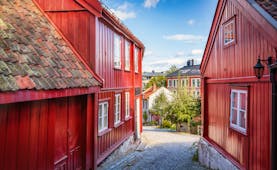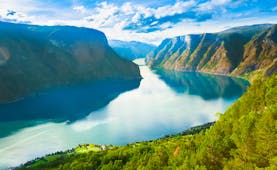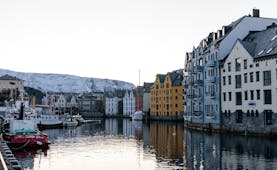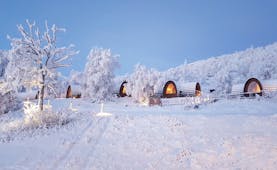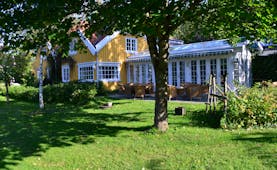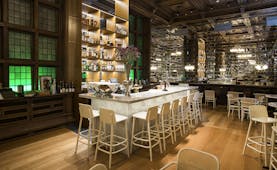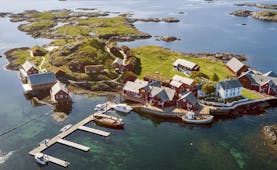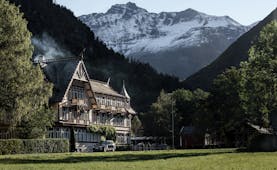Luxury 15-night grand touring holiday of Norway's Arctic regions including the Lofoten Islands, Kirkenes and Tromso
This grand, luxury touring holiday of Norway will take you across some of the northernmost territories on mainland Europe, finishing in the Arctic capital of Tromsø. Start by spending two nights in Trondheim. The third largest city in the country, Trondheim is home to the world’s northernmost cathedral, the Nidaros Cathedral. You may want to explore the picturesque streets of Bakklandet, a small neighbourhood of painted wooden warehouses. From here you travel by train to Bodø, crossing the Arctic Circle as you pass through the Saltfjellet mountain range. Bodø is a relatively small city set amidst some of Norway’s most beautiful scenery. One of its main attractions is the beautiful harbour, whose pier offers stunning views across the Norwegian Sea. For the more adventurous visitors there is a wide range of activities available around the city, from eagle safaris to glacier hiking. After two nights here board the Hurtigruten across to the Lofoten Islands. These islands offer an incredible combination of mountains, fjords and beaches. Using Svolvaer as your base and your hire car to get around, you have two full days here to explore some of the most beautiful beaches in the world and the picturesque fishing villages dotted around the islands. From here you drive to the northernmost tip of the islands at Andenes where you spend one night before taking a morning car ferry over to Gryllefjord on the island of Senja. Spend the afternoon exploring the second-largest island in Norway, home to quaint fishing villages, beautiful beaches and dramatic mountain scenery. From here you drive further north to Alta over 375 km north of the Arctic Circle. One of its greatest historical features is the rock carvings thought to be several thousand years old. The Alta Canyon is a particular highlight and can be explored by land or water. The next day you drive eastwards to Karasjok, the headquarters of the Sami people. The fascinating culture of these indigenous people can be witnessed at the Sami Parliament building and at the Sami Museum. From here it’s another two and a half hour drive to Kirkenes, known for its history and king crab fishing. During World War II this was the site of an important military base, evidence of which can still be seen in the Borderland Museum. After two nights here indulging in Arctic activities you return to western Norway via Hurtigruten cruise ship with your hire-car. You traverse the Barents Sea, along to Varanger Peninsula to Batsfjord. The ship will visit North Cape, the northernmost part of mainland Europe, then continue on to Hammerfest. You arrive into Tromsø in the evening and check in to your hotel for your final 2 nights. The city offers incredible architecture in the Arctic Cathedral and an insight into the lives of polar pioneers at the Polar Museum. On your final day return to the UK by plane via Oslo.
Highlights
Trondheim • Bodø • Lofoten Islands • Senja • Alta • Karasjok • Kirkenes • Hurtigruten cruise • Tromsø
Day by day
This holiday starts with a flight from London to Trondheim, either direct or via a connection in Oslo. Check in to your hotel in Trondheim for two nights.
Trondheim lies on the southern shore of the Trondheimfjord and has played a significant role in Norwegian history. As the country’s first capital city, it was the site where Norwegian kings were crowned for over 700 years, specifically in the Nidaros Cathedral. We highly recommend taking a visit to this beautiful building, which is the world’s northernmost mediaeval cathedral and started construction in 1070. South of this is the striking Archbishop’s Palace Museum, which offers an insight into the 1000-year history of the cathedral and its diocese. You will also find here the Royal Regalia, including the 200-year old Crown of Norway. For a glimpse of the more rustic side of Norwegian life, a visit to the Trøndelag Folk museum is essential: dominated by the ruins of Sverresborg castle, this outdoor museum consists of eighty historic buildings giving information about folk culture as well as rural monuments and the Haltdalen stave church, which dates back 1170. Another picturesque area of the city is Bakklandet, a small neighbourhood of painted wooden warehouses home to galleries, cafes and restaurants.
After two nights in Trondheim you will board the direct Nordland Railway line service to Bodø. This 729 km railway line is Norway’s longest and presents huge variety in culture, climate and landscape. The journey starts by skirting around Trondheim Fjord, reaching the small town of Steinjker two hours later at the head of the longest arm of the fjord. From here you head into the hills. Be sure to notice the colourful station buildings at the small Norwegian towns as you pass by. Leaving the steel works town of Mo I Rana the train skirts the Saltfjellet-Svartisen National Park, passing close by the Swedish border. Shortly after this you cross the Arctic Circle, before heading back towards the coast to reach the shores of Skjerstad Fjord. You continue along this spectacular natural beauty until you reach the station of Bodø, the final stop on the Norwegian railway system and your base for the next two nights.
The city of Bodø is an excellent base from which to explore some of Norway’s best scenery and natural attractions. One of its most well-known features is the Saltstraumen maelstrom, a small strait home to the world’s strongest tidal current. Here you can witness whirlpools bigger 10 metres with the water moving as fast as 40 km/h. Slightly further out of the city is Kjerringøoy, a small, rural community featuring beautiful alpine landscapes ranging from mountains to white sandy beaches. The Kjeringøy trading post is a museum offering a unique insight into the lives of the powerful local merchants and information about the fish trade of the 19th century. For those looking for more adventurous activities, Bodø offers kayaking, RIB tours and even snorkelling in the surrounding fjords, and fishing is a popular local activity. There are also numerous hiking routes including Keiservarden, which leads up to Keiservarden hill overlooking Bodø, and Mount Ronvikfjelet, one of the top viewing spots for the Midnight Sun in the country. Within Bodø itself the beautiful harbour offers views from its pier dating back to 1904 and the Norwegian Aviation Museum offers an insight into the civil and military aviation history of Norway.
After two nights in Bodø you board the Hurtigruten service in the mid-afternoon heading to the Lofoten Islands. This is a journey of roughly six hours which takes you across the open waters of the Vjestfjord to the port of Svolvaer. As you draw closer to the Lofoten Islands its majestic peaks will welcome you as you pull into Svolvaer, the largest town on the islands. We arrange for a taxi to collect you from the port.
This morning collect your hire car and start exploring your surroundings. The Lofoten Islands have some of the most incredible landscapes in the world, ranging from mountains to fjords to white sandy beaches. Your base of Svolvaer is the largest town in the Lofoten Islands and offers fishing excursions and cruises around the islands. Using your hire car we recommend visiting some of the other picturesque fishing villages such as Henningsvaer and Hamnoy, which offer excellent authentic dining options. Nusfjord is one of the best-preserved fishing villages and is now an open-air museum with a sawmill producing cod-liver oil. A perhaps unexpected attraction of the islands is their top-quality beaches. Framed by towering mountains, these stretches of white snad and clear water even offer excellent surfing opportunities, although this is a much more comfortable experience during the summer months. Uttakleiv Beach and Haukland Beach are easily accessible by car and can be reached in just over an hour from Svolvaer. For the best views the Lofoten Islands have to offer we recommend indulging in some of their hiking trails. Reinebringen is the most popular of these with its lookout onto the numerous villages and jagged peaks resting on the calm waters, although this is a relatively challenging hike. For those looking for an easier option Ryten, Svolvaer Floya and Festvagtind are shorter, easier options which still have a rewarding view from the top.
On your final day in the Lofoten Islands drive to the very northern tip of the islands, a journey of about three hours, and a chance to experience more dramatic scenery along the way. The vista is one of mountains, sky, green fields and water.
This morning you take the car ferry from Andenes to Gryllefjord, with a departure daily at 08.45 from 18 May until 3 September, with another departure at 13.00 hrs from 10 June until 13 August. The cost is about NOK 600 and you pay on board the ferry. The journey to Gryllefjord on Senja takes two hours and then it’s about 1 hour and 20 minutes’ drive to your hotel. Given the next day is a long one, it’s worth arriving on Senja with the early ferry so you have some time to explor enja is a lot quieter than most other destinations, giving you chance to truly appreciate the scenery and tranquillity of this beautiful area. You may want to spend your time here exploring the Senja National Tourist Route, which will take you along the island’s rugged outer coastline. Other areas of interest include the Bergsbotn viewing platform which offers an outlook onto the town of Bergsfjord and the surrounding peaks. Hiking is a popular activity here, with the most popular route being Segla. The beaches are also well-worth a visit, in particular Ersfjord Beach, a white sand beach in the town of Ersfjord. Senja is known for its fishing villages, the most active of which is Husøy. This town sits on an island in the middle of the Øyford and is worth visiting for the views en route alone.
After one night on the island of Senja you will drive further into the heart Arctic Norway to Alta, a journey of about six hours. Start by driving along the coast of Senja, skirting the beautiful Anderdalen National Park. You will cross back to mainland Norway at Silsand, arriving at the small town of Finnsnes. Continue along the coast, passing small harbours and quaint boating houses. You will then head further inland, passing through small towns and villages interspersed with dense forest, before skirting the edge of the remote lake of Finnfjordvatnet. As you proceed further north the settlements become less frequent and the mountains become bigger. One of the visual highlights of this journey will be when you join the Northern Lights route, driving along the length of the Lyngenfjord. You will head briefly away from the fjord to travel down remote lanes hemmed in by mountains before heading back to the beauty of the fjord. On the final stretch of the journey more buildings will start to appear again as you draw closer to Alta, also known as the Town of the Northern Lights. Located 375 km above the Arctic Circle, Alta is a small town with a population of just under 15,000 people. One of its most well-known features is the Rock Art of Alta. This is a group of thousands of paintings and engravings dating from around 4200 to 500 B.C. split between 45 different sites, the most of its kind in northern Europe. They are believed to have been made by hunter-gatherers and give an insight into the cosmology of prehistoric peoples. Alta is also known as the Town of the Northern Lights and is home to the world’s first observatory dedicated to studying the Aurora Borealis. The relatively low level of annual precipitation its location on the inner section of the Altafjorden makes it an excellent Northern Light-spotting site. The Northern Lights Cathedral is a large modern church in the town centre designed to represent the lights.
After one night in the Town of the Northern Lights, you travel on to Karasjok, a journey of roughly two and a half hours. Much of the scenery you pass here consists of vast open landscapes interspersed with beautiful clear waters of small lakes. The mountains are much smaller than many other places in Norway but still provide dramatic backgrounds as you traverse the open roads. As you draw further away from Alta you will start to feel like you have entered the true Arctic wilderness with very few settlements to be found. The final stretch as you approach Karasjok will give you tantalising glimpses of the Karasjohka river, which meanders its way through the county of Finnmark. Arrive at the tiny town of Karasjok and check in to your hotel for one night. Karasjok is the headquarter of the Sami people, an indigenous group with a total population of approximately 80,000. This is the oldest culture in large areas of Northern Norway with the current population being the descendants of nomadic peoples who inhabited northern Scandinavia for thousands of years. The Sami Parliament is an important visit if you wish to learn more about these people – opened in 1989 it is the representative body for people of Sami heritage in Norway.
Today you depart Karasjok for your most remote destination – the town of Kirkenes. The first section of this 4-hour journey closely follows the Karasjohka river, which will flit in and out of view as the trees part. Upon reaching the tiny village of Tana you will eventually cross the river, traversing briefly back down the other side before branching off into more isolated scenery consisting of rolling fields and shining lakes. You will pass through the town of Varanger, where you may want to stop at the Varanger Sami Museum to learn more about the culture and history of this indigenous people. From here you venture further south, skirting the edge of the large Varangerfjord, before arriving at Kirkenes in the far east of Norway. You spend two nights here.
This town in the far north-east of Norway has a rich history. During World War II Kirkenes was an important German base where 10,000 soldiers were stationed and the area around the town was the site of some dramatic battles. Over 80 prisons and prisoner of war camps were constructed around Kirkenes and following a disastrous air raid in 1944 it became one of the most bombed areas in Europe. In the centre of Kirkenes you will find a monument dedicated to the memory of the Soviet soldiers who fought and died here, and the Borderland Museum gives a deep insight into this fraught period of history. The museum’s centrepiece is a Soviet military aircraft which crashed into a lake and was recovered in 1947. Another main attraction of Kirkenes is king crab fishing: these enormous crabs can reach 1.5 metres in length and were introduced artificially in the 1960s by the Soviet Union.
The Hurtigruten ferry departs from Kirkenes at 12.30 and arrives at 23.45 the next day. This journey will take you along the outer edge of Norway’s northern coast, allowing you to take in spectacular views of the mountains and fjords. Following a relaxing lunch you will sail across the Barents Sea, with local experts often giving information about the wildlife found in the area such as king crabs and birds. The ship docks in Berlevag in the evening before continuing overnight.
This morning the Hurtigruten cruise ship travels around North Cape to Hammerfest, Norway’s former polar capital, to reach the town at 11.00 you will witness the Meridian column, erected in 1854 to commemorate the Struve international land measurements of the earth. You have one hour and 45 minutes in Hammerfest and excursions can be arranged by Hurtigruten. After crossing the open sea, the ship reaches Tromsø at 23:45. We aim to book you into a hotel opposite the ferry port.
You have today to enjoy the lively city of Tromsø. You can return your car this morning to the downtown office or keep it to drive back to the airport the next day. Tromsø is known by many as the Arctic capital, and for good reason. With its plethora of activities and interesting museums, there is something to do here for everyone. The city is perhaps best-known for being an excellent location to see the Northern Lights. The Polar Night, from mid-November to mid-January, is the best period to witness this extraordinary natural phenomenon, as the sun never rises above the horizon. For an excellent view of these the Storsteinen mountain ledge, reachable via cable car, offers an uninterrupted outlook on the city. This is also a popular location from which to see the Midnight Sun during the summer months. Some of the more adventurous activities offered in Tromsø are whale and dolphin safaris and fjord cruises, where you will witness stunning scenes of snow-capped mountains and cascading waterfalls, and possibly the occasional reindeer. Within the city itself the most striking feature is the Artic Cathedral. Consecrated in 1965, this aluminium and glass building is luminescent during the long polar nights and during the summer there are special Midnight Sun concerts given by professional musicians. Tromsø is also home to several museums: The Polar Museum offers an insight into the lives of polar pioneers, whilst the Tromsø Museum explores the history and geology of the region and its inhabitants.
Today make your way to Tromsø airport for your return flight home via Oslo.
Thank you. We had an amazing holiday. Really appreciate the work put in to give us the trip of a lifetime!Mrs H, Jan 2023
Holiday price guide From £4,110 per person based on two people sharing a double or twin room and a Polar outside cabin on the Kirkenes to Tromsø Hurtigruten overnight cruise.
Holiday Code SCFD06
Call us on 01392 441245
Luxury 15-night grand touring holiday of Norway's Arctic regions including the Lofoten Islands, Kirkenes and Tromso
This holiday starts with a flight from London to Trondheim, either direct or via a connection in Oslo. Check in to your hotel in Trondheim for two nights.
Trondheim lies on the southern shore of the Trondheimfjord and has played a significant role in Norwegian history. As the country’s first capital city, it was the site where Norwegian kings were crowned for over 700 years, specifically in the Nidaros Cathedral. We highly recommend taking a visit to this beautiful building, which is the world’s northernmost mediaeval cathedral and started construction in 1070. South of this is the striking Archbishop’s Palace Museum, which offers an insight into the 1000-year history of the cathedral and its diocese. You will also find here the Royal Regalia, including the 200-year old Crown of Norway. For a glimpse of the more rustic side of Norwegian life, a visit to the Trøndelag Folk museum is essential: dominated by the ruins of Sverresborg castle, this outdoor museum consists of eighty historic buildings giving information about folk culture as well as rural monuments and the Haltdalen stave church, which dates back 1170. Another picturesque area of the city is Bakklandet, a small neighbourhood of painted wooden warehouses home to galleries, cafes and restaurants.
After two nights in Trondheim you will board the direct Nordland Railway line service to Bodø. This 729 km railway line is Norway’s longest and presents huge variety in culture, climate and landscape. The journey starts by skirting around Trondheim Fjord, reaching the small town of Steinjker two hours later at the head of the longest arm of the fjord. From here you head into the hills. Be sure to notice the colourful station buildings at the small Norwegian towns as you pass by. Leaving the steel works town of Mo I Rana the train skirts the Saltfjellet-Svartisen National Park, passing close by the Swedish border. Shortly after this you cross the Arctic Circle, before heading back towards the coast to reach the shores of Skjerstad Fjord. You continue along this spectacular natural beauty until you reach the station of Bodø, the final stop on the Norwegian railway system and your base for the next two nights.
The city of Bodø is an excellent base from which to explore some of Norway’s best scenery and natural attractions. One of its most well-known features is the Saltstraumen maelstrom, a small strait home to the world’s strongest tidal current. Here you can witness whirlpools bigger 10 metres with the water moving as fast as 40 km/h. Slightly further out of the city is Kjerringøoy, a small, rural community featuring beautiful alpine landscapes ranging from mountains to white sandy beaches. The Kjeringøy trading post is a museum offering a unique insight into the lives of the powerful local merchants and information about the fish trade of the 19th century. For those looking for more adventurous activities, Bodø offers kayaking, RIB tours and even snorkelling in the surrounding fjords, and fishing is a popular local activity. There are also numerous hiking routes including Keiservarden, which leads up to Keiservarden hill overlooking Bodø, and Mount Ronvikfjelet, one of the top viewing spots for the Midnight Sun in the country. Within Bodø itself the beautiful harbour offers views from its pier dating back to 1904 and the Norwegian Aviation Museum offers an insight into the civil and military aviation history of Norway.
After two nights in Bodø you board the Hurtigruten service in the mid-afternoon heading to the Lofoten Islands. This is a journey of roughly six hours which takes you across the open waters of the Vjestfjord to the port of Svolvaer. As you draw closer to the Lofoten Islands its majestic peaks will welcome you as you pull into Svolvaer, the largest town on the islands. We arrange for a taxi to collect you from the port.
This morning collect your hire car and start exploring your surroundings. The Lofoten Islands have some of the most incredible landscapes in the world, ranging from mountains to fjords to white sandy beaches. Your base of Svolvaer is the largest town in the Lofoten Islands and offers fishing excursions and cruises around the islands. Using your hire car we recommend visiting some of the other picturesque fishing villages such as Henningsvaer and Hamnoy, which offer excellent authentic dining options. Nusfjord is one of the best-preserved fishing villages and is now an open-air museum with a sawmill producing cod-liver oil. A perhaps unexpected attraction of the islands is their top-quality beaches. Framed by towering mountains, these stretches of white snad and clear water even offer excellent surfing opportunities, although this is a much more comfortable experience during the summer months. Uttakleiv Beach and Haukland Beach are easily accessible by car and can be reached in just over an hour from Svolvaer. For the best views the Lofoten Islands have to offer we recommend indulging in some of their hiking trails. Reinebringen is the most popular of these with its lookout onto the numerous villages and jagged peaks resting on the calm waters, although this is a relatively challenging hike. For those looking for an easier option Ryten, Svolvaer Floya and Festvagtind are shorter, easier options which still have a rewarding view from the top.
On your final day in the Lofoten Islands drive to the very northern tip of the islands, a journey of about three hours, and a chance to experience more dramatic scenery along the way. The vista is one of mountains, sky, green fields and water.
This morning you take the car ferry from Andenes to Gryllefjord, with a departure daily at 08.45 from 18 May until 3 September, with another departure at 13.00 hrs from 10 June until 13 August. The cost is about NOK 600 and you pay on board the ferry. The journey to Gryllefjord on Senja takes two hours and then it’s about 1 hour and 20 minutes’ drive to your hotel. Given the next day is a long one, it’s worth arriving on Senja with the early ferry so you have some time to explor enja is a lot quieter than most other destinations, giving you chance to truly appreciate the scenery and tranquillity of this beautiful area. You may want to spend your time here exploring the Senja National Tourist Route, which will take you along the island’s rugged outer coastline. Other areas of interest include the Bergsbotn viewing platform which offers an outlook onto the town of Bergsfjord and the surrounding peaks. Hiking is a popular activity here, with the most popular route being Segla. The beaches are also well-worth a visit, in particular Ersfjord Beach, a white sand beach in the town of Ersfjord. Senja is known for its fishing villages, the most active of which is Husøy. This town sits on an island in the middle of the Øyford and is worth visiting for the views en route alone.
After one night on the island of Senja you will drive further into the heart Arctic Norway to Alta, a journey of about six hours. Start by driving along the coast of Senja, skirting the beautiful Anderdalen National Park. You will cross back to mainland Norway at Silsand, arriving at the small town of Finnsnes. Continue along the coast, passing small harbours and quaint boating houses. You will then head further inland, passing through small towns and villages interspersed with dense forest, before skirting the edge of the remote lake of Finnfjordvatnet. As you proceed further north the settlements become less frequent and the mountains become bigger. One of the visual highlights of this journey will be when you join the Northern Lights route, driving along the length of the Lyngenfjord. You will head briefly away from the fjord to travel down remote lanes hemmed in by mountains before heading back to the beauty of the fjord. On the final stretch of the journey more buildings will start to appear again as you draw closer to Alta, also known as the Town of the Northern Lights. Located 375 km above the Arctic Circle, Alta is a small town with a population of just under 15,000 people. One of its most well-known features is the Rock Art of Alta. This is a group of thousands of paintings and engravings dating from around 4200 to 500 B.C. split between 45 different sites, the most of its kind in northern Europe. They are believed to have been made by hunter-gatherers and give an insight into the cosmology of prehistoric peoples. Alta is also known as the Town of the Northern Lights and is home to the world’s first observatory dedicated to studying the Aurora Borealis. The relatively low level of annual precipitation its location on the inner section of the Altafjorden makes it an excellent Northern Light-spotting site. The Northern Lights Cathedral is a large modern church in the town centre designed to represent the lights.
After one night in the Town of the Northern Lights, you travel on to Karasjok, a journey of roughly two and a half hours. Much of the scenery you pass here consists of vast open landscapes interspersed with beautiful clear waters of small lakes. The mountains are much smaller than many other places in Norway but still provide dramatic backgrounds as you traverse the open roads. As you draw further away from Alta you will start to feel like you have entered the true Arctic wilderness with very few settlements to be found. The final stretch as you approach Karasjok will give you tantalising glimpses of the Karasjohka river, which meanders its way through the county of Finnmark. Arrive at the tiny town of Karasjok and check in to your hotel for one night. Karasjok is the headquarter of the Sami people, an indigenous group with a total population of approximately 80,000. This is the oldest culture in large areas of Northern Norway with the current population being the descendants of nomadic peoples who inhabited northern Scandinavia for thousands of years. The Sami Parliament is an important visit if you wish to learn more about these people – opened in 1989 it is the representative body for people of Sami heritage in Norway.
Today you depart Karasjok for your most remote destination – the town of Kirkenes. The first section of this 4-hour journey closely follows the Karasjohka river, which will flit in and out of view as the trees part. Upon reaching the tiny village of Tana you will eventually cross the river, traversing briefly back down the other side before branching off into more isolated scenery consisting of rolling fields and shining lakes. You will pass through the town of Varanger, where you may want to stop at the Varanger Sami Museum to learn more about the culture and history of this indigenous people. From here you venture further south, skirting the edge of the large Varangerfjord, before arriving at Kirkenes in the far east of Norway. You spend two nights here.
This town in the far north-east of Norway has a rich history. During World War II Kirkenes was an important German base where 10,000 soldiers were stationed and the area around the town was the site of some dramatic battles. Over 80 prisons and prisoner of war camps were constructed around Kirkenes and following a disastrous air raid in 1944 it became one of the most bombed areas in Europe. In the centre of Kirkenes you will find a monument dedicated to the memory of the Soviet soldiers who fought and died here, and the Borderland Museum gives a deep insight into this fraught period of history. The museum’s centrepiece is a Soviet military aircraft which crashed into a lake and was recovered in 1947. Another main attraction of Kirkenes is king crab fishing: these enormous crabs can reach 1.5 metres in length and were introduced artificially in the 1960s by the Soviet Union.
The Hurtigruten ferry departs from Kirkenes at 12.30 and arrives at 23.45 the next day. This journey will take you along the outer edge of Norway’s northern coast, allowing you to take in spectacular views of the mountains and fjords. Following a relaxing lunch you will sail across the Barents Sea, with local experts often giving information about the wildlife found in the area such as king crabs and birds. The ship docks in Berlevag in the evening before continuing overnight.
This morning the Hurtigruten cruise ship travels around North Cape to Hammerfest, Norway’s former polar capital, to reach the town at 11.00 you will witness the Meridian column, erected in 1854 to commemorate the Struve international land measurements of the earth. You have one hour and 45 minutes in Hammerfest and excursions can be arranged by Hurtigruten. After crossing the open sea, the ship reaches Tromsø at 23:45. We aim to book you into a hotel opposite the ferry port.
You have today to enjoy the lively city of Tromsø. You can return your car this morning to the downtown office or keep it to drive back to the airport the next day. Tromsø is known by many as the Arctic capital, and for good reason. With its plethora of activities and interesting museums, there is something to do here for everyone. The city is perhaps best-known for being an excellent location to see the Northern Lights. The Polar Night, from mid-November to mid-January, is the best period to witness this extraordinary natural phenomenon, as the sun never rises above the horizon. For an excellent view of these the Storsteinen mountain ledge, reachable via cable car, offers an uninterrupted outlook on the city. This is also a popular location from which to see the Midnight Sun during the summer months. Some of the more adventurous activities offered in Tromsø are whale and dolphin safaris and fjord cruises, where you will witness stunning scenes of snow-capped mountains and cascading waterfalls, and possibly the occasional reindeer. Within the city itself the most striking feature is the Artic Cathedral. Consecrated in 1965, this aluminium and glass building is luminescent during the long polar nights and during the summer there are special Midnight Sun concerts given by professional musicians. Tromsø is also home to several museums: The Polar Museum offers an insight into the lives of polar pioneers, whilst the Tromsø Museum explores the history and geology of the region and its inhabitants.
Today make your way to Tromsø airport for your return flight home via Oslo.
Thank you. We had an amazing holiday. Really appreciate the work put in to give us the trip of a lifetime!Mrs H, Jan 2023
Holiday price guide From £4,110 per person based on two people sharing a double or twin room and a Polar outside cabin on the Kirkenes to Tromsø Hurtigruten overnight cruise.
Holiday Code SCFD06
Our prices include
● Flight from London to Trondheim and Tromsø to London via Oslo.
● Second-class travel on all trains (Plus class available on certain trains can be booked at a supplement)
● Hurtigruten ship from Bodø to Svolvaer as foot passengers (no cabin)
● Hurtigruten ship from Kirkenes to Tromsø with car and with Polar outside cabin
● Hire of a group B car for 10 days (a one-way drop-off fee is payable)
● 2 nights’ bed and breakfast in a Superior double room at Britannia Hotel, Trondheim
● 2 nights’ bed and breakfast in a Standard double room at the Thon Hotel Nordlys, Bodø
● 2 nights’ bed and breakfast in a Rorbu S cabin at Svinøya Rorbuer, Svolvaer
● 1 night’s bed and breakfast in a Standard double room at Thon Hotel Andrikken, Andenes
● 1 night’s bed and breakfast in a Standard double room at Senja Fjordhotel, Senja
● 1 night’s bed and breakfast in a Standard double room at Scandic Alta, Alta
● 1 night’s bed and breakfast in a Standard double room at Scandic Karasjok, Karasjok
● 2 nights’ half board in a Gamme cabin at Kirkenes Snowhotel, Kirkenes
● 2 nights’ bed and breakfast in a Standard double room at Clarion the Edge or Scandic Ishavshotel in Tromsø
● Taxi transfer in Svolvaer from port to hotel on arrival
● Concierge service and Expressions Holidays regional helpful hints
Our prices do not include
● Early check-in or late check-out at any hotels (although we can arrange this on request at additional cost)
● Any other services not mentioned above, such as transfers and meals except breakfast at hotels
● Personal holiday insurance. This is essential and cover should be in place from when you book the holiday.
● Possible local tourist tax, usually the equivalent of £1 to £3 per person per night, and payable locally to the hotel
● Transfers other than one in Svolvaer
● One-way drop-off charge for the hire-car (about £450 for picking up in Svolvaer and dropping off in Tromsø
Additional information This holiday can be arranged from May to October. Timings can vary depending on the month and day of the week.
Call us on 01392 441245
Luxury 15-night grand touring holiday of Norway's Arctic regions including the Lofoten Islands, Kirkenes and Tromso

The Britannia Hotel is a traditional, grand, 5-star hotel in the centre of Trondheim, completely refurbished in 2019. Luxurious but discreet rooms, four dining options, bar and wine bar, spa.
Superior double room

The Thon Hotel Nidaros is a 4-star hotel in a central location offering bright, comfortable rooms in a Gothic-style building.
Standard double

Thon Hotel Nordlys in Bodø is a modern 4-star hotel next the city’s marina offering comfortable, brightly-furnished rooms with a bar and restaurant.
Standard double

Svinøya Rorbuer are traditional fishermen’s cabins of the Lofoten Islands, renovated and charming, but with a sense of history.
Rorbu S cabin

This is a minimalistic, family-run hotel situated on the fjord in an idyllic bay, ideal for relaxation exploration of the island of Senja
Standard double room

The Snowhotel Kirkenes provides a unique Arctic experience with accommodation in both ice rooms and traditional wooden cabins, along with a range of local experiences.
Gamme cabin
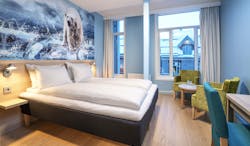
The Thon Hotel Polar Tromsø is a contemporary 4-star hotel in a central location offering comfortable, brightly-furnished rooms and an adjacent restaurant.
Standard double
Thank you. We had an amazing holiday. Really appreciate the work put in to give us the trip of a lifetime!Mrs H, Jan 2023
Holiday price guide From £4,110 per person based on two people sharing a double or twin room and a Polar outside cabin on the Kirkenes to Tromsø Hurtigruten overnight cruise.
Holiday Code SCFD06
Call us on 01392 441245
Luxury 15-night grand touring holiday of Norway's Arctic regions including the Lofoten Islands, Kirkenes and Tromso
About Trondelag
Trøndelag is the region at whose heart sits the city of Trondheim, ancient capital of the kingdom of Norway and a place of pilgrimage in Scandinavia. Trøndelag is north of Vestlandet and hugs the rugged coastline with interiors of coniferous and deciduous forests. Trondheim, once known as Nidaros, is where King Olav Haraldsson was canonised in 1031 and today contains a charming mixture of historic sights and stylish, modern architecture. There are interesting museums (Museum of Art, the Maritime Museum, the Trødelag folk museum and the Museum of Decorative Arts), the warehouses of Bryggen, the royal residence and the Nidarosdomen, Scandinavia’s greatest mediaeval building, built over the grave of Olav the Holy, the patron saint of Norway. Inland is the well-preserved mining town of Røros, with colourful, wooden houses with turf roofs. Since the 17th Century until 1977, the community combined agriculture with copper-mining. At Austrått you’ll find a beautiful white manor house dating from the Viking age, and one of the best-preserved mediaeval buildings in Norway. Just offshore are several islands including Munkholmen, Hitra and Frøya. The latter two are renowned for their deep-sea fishing.
Highlights of Trøndelag
Trondheim, once the Viking capital of Norway, and today Norway’s third city, known as the culinary capital of the country. Scenic attractions of the fjords, the Nidelva River and forests nearby. There is the Bymarka Nature Reserve, the Lade Trail and the island of Munkholmen. In the city itself, historic sites include Nidaros Cathedral, dating from 1070, the Archbishop’s Palace, Stiftsgården, Kristiansten Fortress, Bakklandet old town, and the Trøndelag Folk Museum. Between September and March, you can book an Aurora Borealis (Northern Lights) experience from Trondheim (book at least 48 hours in advance through the Visit Trondheim tourist office).
Cultural highlights of Trøndelag
Trondheim is often the focal point for stays in this area and the ancient city is bursting with cultural activities and sites: Nidaros Cathedral, Trondheim maritime museum, the Armory, the historic wharves, Steinvikholm castle. The Trondheim Symphony Orchestra and Opera give performances. Visit the Sverresborg Trondelag folk museum and the University museum. A short distance from Trondheim by train is the ancient mining town and now UNESCO World Heritage site of Røros. The old mining town is well preserved and the town has strong Sami traditions.
Festivals of Trøndelag
Røros has a 6-day winter fair, summer Olavsfest in Trondheim, Trondheim International Folm Festival, Trøndelag food festival, Jazz festival in May
Gastronomy of Trøndelag
The area is strong on seafood and fish. Hitra crab and Froya scallops are local foods. The region is also known for its cloudberries and reindeer meat. The countryside produces slow-growing vegetables. Must try specialities include crab, langoustine and other shellfish from Hitra and Froya; reindeer, moose and venison; cured meats and homemade flatbread; local baked goods such as lefse, lemse and pjalt; blue cheese and others. The region has many microbreweries and produces local juices.
Call us on 01392 441245
Luxury 15-night grand touring holiday of Norway's Arctic regions including the Lofoten Islands, Kirkenes and Tromso
About Northern Norway
This northernmost region of the country, with the large part of it sitting within the Arctic Circle, is one that conjures up much of the magic for the visitor to Norway. This is the land of snow and ice, endless tundra, red-painted houses of fishing villages, the land of the midnight sun and the eerily mystical Northern Lights. Perched on the coast near Narvik are the idyllic Lofoten Islands, with craggy peaks, inlets and fjords, fishing villages and farms. Svolvaer is the gateway to the Lofoten Islands and from here you can visit the charming villages of Reine, Stramsund, Ballstad and Nusfjord. The main town of the region is Tromsø, situated about 186 miles inside the Arctic Circle and the place from where Amundsen started his polar expedition. The town is a popular place for viewing the Northern Lights. Other places you might visit depending on how you travel through this region are Mo I Rana, Bodø and Narvik. From Narvik you can take the train to Kiruna in Sweden and on to Stockholm (by sleeper train).
Highlights of Northern Norway
Places of interest include the Lofoten Aquarium, the Lofotr Vikingmuseum, farm visits and visits to meet the locals. You can experience the Midnight Sun in summer and undertake many activities such as climbing, hiking, sailing, kayaking, sea safaris to visit Trollfjord and watch for sea eagles, fishing trips. There are scenic routes around the Lofoten Island affording ample photo opportunities and the chance to see striking artwork set amongst the natural landscape and near the viewing points. There are several art galleries on the Lofoten Islands displaying not only paintings and prints, but also glasswork and Lofoten woollen goods. From Bodø there are numerous hiking trails near the hotel, with the hotel recommending the Ramnfloget, Keiservarden, Ørnkloa, Bestefarvarden, and Finnkonnakken. There are also RIB excursions available nearby, and the area is home to the famous Saltstraumen maelstrom. Bodø is a short distance away, with restaurants, bars, shops, and museums, such as the Norwegian Aviation Museum. Mjelle Beach is further up the coast, known for its red sand, infused with garnet. Tromsø recommended highlights: Arctic Cathedral, Storsteinen mountain ledge, Polar Museum, Tromsø Museum, dolphin safaris, fjord cruises, Northern Light searches.
Cultural highlights of Northern Norway
Tromsø is home to a number of museums including the Polar Museum and the Tromsø museum. Svolvaer has its own local history museum and on Lofoten there is a Viking long house and museum. Near Bodø is the Kjerringoy trading post and the Bunkermuseum. Northern Norway is home to the Sami people and you can experience the Sami culture in a number of locations: reindeer herding, joik (Sami folk music), silver working, Sami clothing and ceramics.
Festivals of Northern Norway
Northern Lights festival in Tromsø held at the end of January, the Arctic Arts Festival in Harstad during the summer solstice in June and the Lofoten International Art Festival, which takes place alternate years and features contemporary art. Tromsø holds a jazz festival in the summer.
Gastronomy of Northern Norway
Stockfish is one of the signature dishes (dried cod served with carrots, bacon and scrambled eggs). All manner of fish and seafood: halibut, cod, herring, haddock, mussels, prawns and lobsters. Skrei is the wandering Atlantic cod, and one of the most protected and sustainable fish stocks in the world. Seaweed is harvested in the Lofoten islands and King crab is a delicacy in the region. Herring is served in a variety of ways: fresh, smoked, salted and pickled. Reindeer is a delicacy in northern Norway and is often roasted or cooked in stews. Lamb are reared locally on the Lofoten islands and on the Lyngen peninsula. Cloudberries are picked to make jam and desserts. The Mack brewery is based in Tromsø and produces popular local beers.












